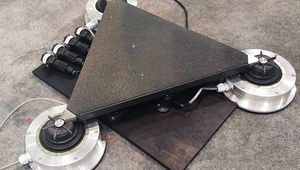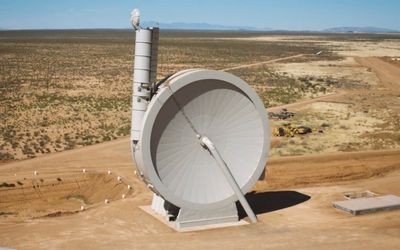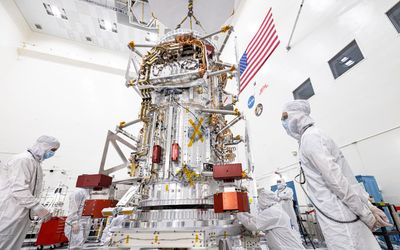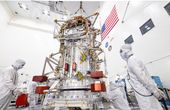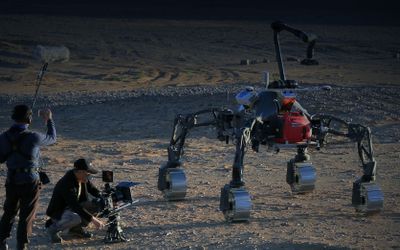Falcon 9 v1.2 or Full Thrust - Block 5
Reusable two-stage rocket for reliable & safe transport of payloads and people into orbit.
Technical Specifications
| OVERVIEW | |
| Height | 70 m / 229.6 ft |
| Diameter | 3.7 m / 12 ft |
| Mass | 549,054 kg / 1,207,920 lb |
| Payload To LEO | 22,800 kg / 50,265 lb |
| Payload To GTO | 8,300 kg / 18,300 lb |
| Payload To Mars | 4,020 kg / 8,860 lb |
| FIRST STAGE | |
| Height | 41.2 m / 135.2 ft |
| Height (with interstage) | 47.7 m / 156.5 ft |
| Diameter | 3.7 m / 12 ft |
| Empty Mass | 25,600 kg / 56,423 lb |
| Propellant Mass | 395,700 kg/ 872,369 lb |
| Structure Type | LOX tank: monocoque |
| Fuel tank: skin and stringer | |
| Structure Material | Aluminum lithium skin; aluminum domes |
| Landing Legs | Number: 4 |
| Material: carbon fiber; aluminum honeycomb | |
| Number Of Merlin Engines | 9 sea level |
| Propellant | LOX / RP-1 |
| Thrust At Sea Level | 7,607 kN / 1,710,000 lbf |
| Thrust In Vacuum | 8,227 kN / 1,849,500 lbf |
| Specific Impulse (sea-level) | 283 sec. |
| Specific Impulse (vacuum Sec) | 312 sec. |
| Burn Time | 162 sec. |
| Ascent Attitude Control - Pitch, Yaw | Gimbaled engines |
| Ascent Attitude Control - Roll | Gimbaled engines |
| Coast/Descent Attitude Control | Nitrogen gas thrusters and grid fins |
| SECOND STAGE | |
| Height | 13.8 m / 45.3 ft |
| Diameter | 3.7 m / 12.1 ft |
| Empty Mass | 3,900 kg / 8,598 lb |
| Propellant Mass | 92,670 kg / 204,302 lb |
| Structure Type | LOX tank: monocoque |
| Fuel tank: skin and stringer | |
| Structure Material | Aluminum lithium skin; aluminum domes |
| Number Of Merlin Engines | 1 vacuum |
| Propellant | LOX / RP-1 |
| Thrust | 981 kN / 220,500 lbf |
| Specific Impulse (vacuum) | 348 sec |
| Burn Time | 397 sec |
| Ascent Attitude Control - Pitch, Yaw | Gimbaled engine and nitrogen gas thrusters |
| Ascent Attitude Control - Roll | Nitrogen gas thrusters |
| Coast/Descent Attitude Control | Nitrogen gas thrusters |
| PAYLOAD - FAIRING | |
| Height | 13.1 m / 43 ft |
| Diameter | 5.2 m / 17.1 ft |
| PAYLOAD - DRAGON | |
| Height | 8.1 m / 26.6 ft |
| Diameter | 3.7 m / 12 ft |
| ENGINES – MERLIN – SEA LEVEL | |
| Model | Merlin-1D++ |
| Propellant | LOX / RP-1 |
| Thrust | 845 kN / 190,000 lbf |
| Nozzles | Gimbaled, 16:1 expansion |
| ENGINES – MERLIN – VACUUM | |
| Model | Merlin-1DV+ |
| Propellant | LOX / RP-1 |
| Thrust | 981 kN / 220,500 lbf |
| Nozzles | Gimbaled, 165:1 expansion |
Overview
Overview
SpaceX designed and manufactured the Falcon 9 as a medium- to heavy-lift rocket. It is the first and only rocket to launch and soft-land a first stage after delivering payloads to orbit.
Problem / Solution
Access to space is a complex and costly endeavor. Governments and private companies worldwide have struggled with the impracticality of building an expensive rocket for a single mission.
SpaceX's Falcon 9 is a reusable, two-stage rocket designed and built for the reliable and safe transportation of people and cargo into Earth’s orbit. After transporting satellites into orbit or people to the International Space Station, the first-stage boosters will withstand reentry to Earth, land safely, and be prepared for the next launch with minimal refurbishing. The first stage boosters undergo a strict inspection for any damages, replacement of some individual parts, and a pre-launch static fire of all nine Merlin engines, all for less than a million dollars. Since the rocket's most valuable and expensive parts are reused, Falcon 9 substantially reduces space access costs.
Flight Sequence
When all nine Merlin engines reach full power, the Falcon 9 takes off. The gimbal-mounted engines handle pitch, yaw, and roll control. The first stage booster burns for 162 seconds before it burns out and is ejected. Following the separation of the first stage, the Merlin engine in the second stage ignites and transports the payload to a parking orbit before igniting again to place it in its final orbit. The payload fairing is ejected once positioned in its final orbit, and shortly after the reignition of the second stage.
After being ejected, the first stage performs a flip maneuver to reorient itself using its cold gas thrusters and begins its powered return to Earth. The first stage flies to land or a drone ship in the Atlantic Ocean using a combination of reaction control thrusters, forward-mounted grid fins, and thrust from one or three of the main Merlin engines. The engines perform a "boostback burn" to bring trajectory toward the landing site, deploy grid finds, "entry burn" to slow down the first stage, aerodynamic guidance, and then "landing burn" for a precise landing as it deploys landing legs and lands upright.
Design
The Falcon 9 is composed of four main components: the first stage rocket, the interstage, the second stage rocket, and the payload fairing.
First stage
The first stage of the Falcon 9 is comprised of nine Merlin gimbaled engines and aluminum-lithium alloy tanks containing high-density chilled liquid oxygen (LOX) and cooled rocket-grade kerosene (RP-1) propellant. Its primary purpose is to ascend to orbit. The first stage engines are arranged in a circular configuration called “Octaweb” pattern, with eight engines surrounding a center engine. This pattern reduces the booster’s length and weight, and simplifies the rocket’s design and assembly. Falcon 9's first stage at sea level generates around 7,607 kilonewtons of thrust. The first stage engines gradually throttle down to limit acceleration as the rocket's mass decreases due to fuel combustion. These engines also reorient the first stage using cold gas thrusters before reentry and decelerate the vehicle in preparation for landing on a free-floating ship at sea or in a specific location on land. The Falcon 9 first stage has four landing legs made of advanced aluminum honeycomb carbon fiber sheet. They are stowed symmetrically around the first stage's base and deploy just before landing.
Second stage
The second stage of the Falcon 9 is powered by a single Merlin Vacuum Engine and aluminum-lithium alloy tanks containing the same propellant as the first stage. Its primary purpose is to deliver Falcon 9’s payload to the desired orbit. Falcon 9's second stage in vacuum generates around 981 kilonewtons of thrust. The second stage engine ignites shortly after stage separation and can be reignited many times to position multiple payloads into different target orbits. It also uses cold nitrogen gas (GN2) attitude control system (ACS) for a more reliable pointing and roll control.
Interstage
The interstage is a composite structure that joins the first and second stages. Its primary purpose is to allow the separation of the first and second stage mid-flight with its pneumatic pushers. Four hypersonic titanium grid fins are positioned at the interstage’ base to orient the rocket during reentry by shifting the center of pressure.
Payload fairing
The payload fairing houses and protects the cargo during the mission. There are two available payload fairings: the standard fairing and the Dragon. The fairing is made of carbon composite material with the function of protecting satellites as they travel into orbit. It is ejected after being positioned at the target orbit and is recovered for reuse on future missions. The Dragon is a pressurized payload fairing with the primary function of transporting up to 7 people and can also accommodate secondary payloads of its unpressurized trunk.
Merlin engines
The Merlin rocket engines are specifically developed for recovery and reuse features of the Falcon series of launch vehicles. These engines are gimbaled and have throttle and restart capability for high degrees of control. Two of the nine Merlin engines in the first stage of the Falcon 9 can malfunction without affecting the launch. Merlin engines utilize cooled rocket-grade kerosene (RP-1) and chilled liquid oxygen as rocket propellants in an open-cycle or gas-generator power cycle. A Turbopump feed system feeds the propellant, heated helium pressurizes the fuel tank. and dual redundant triethylaluminum-triethylborane (TEA-TEB) pyrophoric igniters for restart reliability.
The two engines used in the Falcon 9 are the Sea Level Merlin engine and the Vacuum Merlin engine. The Sea Level Merlin engines with a smaller exhaust section and 16:1 expansion nozzle primarily for ascent from Earth are used in the first stage of Falcon 9. The Vacuum Merlin engine used in the second stage has a larger expansion nozzle of 165:1 and a bigger exhaust section to maximize efficiency in the vacuum. The combustion chamber is cooled by regenerative cooling, while the expansion nozzle is by radiative cooling.
Post-Flight
The first stage booster is returned to the Horizontal Integration Facility after a successful landing to be inspected, refurbished, and ready for another launch. Each engine is subjected to various rigorous tests to ensure that every component is prepared for flight. Only some individual parts like the turbine wheels and rarely the whole Merlin engine are replaced to ensure the best performance. The propellant tanks and pressure vessels are subjected to a series of ultrasonic tests and X-ray inspections to check the welds and look for tiny cracks that could cause the rocket to fail once it is pressurized for flight. SpaceX only cleans the soot deposits of the parts that require inspection, such as welds. Following the inspection process and prior to payload attachment, a pre-launch static fire test with all nine engines is performed.
Each mission will provide data on the boosters' reusability and how to improve the refurbishment process to achieve the 24 hours refurbishment time with only a few quick inspections between flights. With an approximate $50 million for launching a new Falcon 9 and $15 million marginal cost of launching a reused Falcon 9 with $0.25 million for booster refurbishments, it is less expensive to reuse the booster up to a theoretical 100 launches than building a new one each launch.


